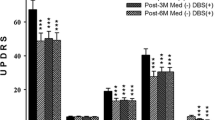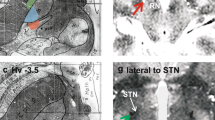Abstract
The aim of the present study was to assess the efficacy and safety of chronic subthalamic nucleus deep-brain stimulation (STN-DBS) in patients with Parkinson's disease (PD). 18 consecutive severely affected PD patients were included (mean age, SD: 56.9±6 years; mean disease duration: 13.5±4.4 years). All the patients were evaluated clinically before and 6 months after the surgical procedure using the Unified Parkinson's Disease Rating Scale (UPDRS). Additionally, a 12 months follow-up was available in 14 patients. The target coordinates were determined by ventriculography under stereotactic conditions, followed by electrophysiology and intraoperative stimulation. After surgery, continuous monopolar stimulation was applied bilaterally in 17 patients at 2.9±0.4 V through 1 (n = 31) or 2 contacts (n = 3). One patient had bilateral bipolar stimulation. The mean frequency of stimulation was 140±16 Hz and pulse width 68±13 μs. Off medication, the UPDRS part III score (max = 108) was reduced by 55 % during on stimulation (score before surgery: 44.9±13.4 vs at 6 months: 20.2±10; p < 0.001). In the on medication state, no difference was noted between the preoperative and the postoperative off stimulation conditions (scores were respectively: 17.9±9.2 and 23±12.6). The severity of motor fluctuations and dyskinesias assessed by UPDRS IV was reduced by 76 % at 6 months (scores were respectively: 10.3±3 and 2.5±3; p < 0.001). Off medication, the UPDRS II or ADL score was reduced by 52.8 % during on stimulation (26.9±6.5 preop versus 12.7±7 at 6 months). The daily dose of antiparkinsonian treatment was diminished by 65.5 % (levodopa equivalent dose – mg/D – was 1045 ± 435 before surgery and 360 ± 377 at 6 months; p < 0.01). These results remained stable at 12 months for the 14 patients studied. Side effects comprised lower limb phlebitis (n = 2), pulmonary embolism (n = 1), depression (n = 6), dysarthria and freezing (n = 1), sialorrhea and drooling (n = 1), postural imbalance (n = 1), transient paresthesias and dyskinesias. This study confirms the great value of subthalamic nucleus stimulation in the treatment of intractable PD. Some adverse events such as depression may be taken into account in the inclusion criteria and also in the post-operative outcome.
Similar content being viewed by others
Author information
Authors and Affiliations
Additional information
Received: 30 May 2001, Received in revised form: 21 September 2001, Accepted: 26 September 2001
Rights and permissions
About this article
Cite this article
Thobois, S., Mertens, P., Guenot, M. et al. Subthalamic nucleus stimulation in Parkinson's disease. J Neurol 249, 529–534 (2002). https://doi.org/10.1007/s004150200059
Published:
Issue Date:
DOI: https://doi.org/10.1007/s004150200059




